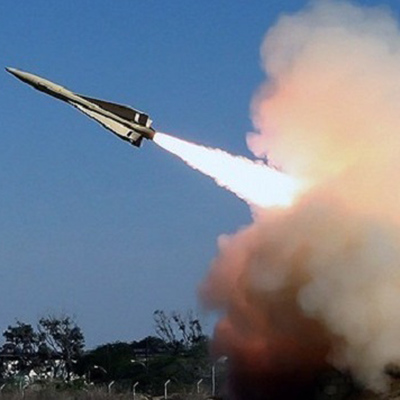Warfare
The Exocet Missile
Written by: Mohsen Shirmuhammad,
Translated by: Hadi Qorbanyar
83 دورہ
The French-built Exocet missile was extensively employed by the Iraqi military in the eight-year Iran–Iraq War to attack both Iranian naval and civilian vessels in the Persian Gulf.
The Exocet (literally meaning “flying fish”) measures 4.7 meters in length with a diameter of 350 millimeters and a total weight of 670 kilograms. It carries a 165-kilogram warhead, has an effective range of about 70 kilometers, and later versions are capable of reaching up to 180 kilometers. Guided by active radar homing, the missile flies at a very low altitude—just two meters above the water’s surface—and is specifically designed to destroy small and medium-sized warships such as frigates and destroyers.[1] Large vessels like aircraft carriers, however, are far less vulnerable to this missile.[2]
At the outset of the war, Iraq relied on Super Frelon helicopters to launch Exocet missiles against ships in the Khor Musa channel and near Bandar Imam Khomeini. Because these helicopters lacked identification friend-or-foe systems,[3] they occasionally targeted commercial ships carrying cargo bound for Iraq itself.[4] Attacks on oil installations and offshore platforms in the northern Persian Gulf were also carried out by Super Frelons armed with Exocets.[5]
On October 2, 1982, the Iranian vessel Kahnamuei was hit and destroyed by an Exocet missile near Kharg Island.[6] Subsequent operations included repeated strikes against oil facilities and installations in the northern Persian Gulf, as well as against some Iranian islands such as Kharg.[7]
As the conflict continued, Iraq started using Exocet missiles against Iranian oil tankers. Helicopters equipped with missiles attacked 20 Iranian tankers in the northern Persian Gulf.[8] Later, the Iraqi Air Force employed Super Étendard aircraft armed with Exocets. In their first operation, on March 27, 1984,[9] one of these aircraft mistakenly fired an Exocet at the Greek tanker Filikon, which was carrying 80,000 tons of Kuwaiti oil south of Kharg Island.[10]
On Friday, December 21, 1984, an Iraqi Super Étendard aircraft fired Exocet missiles at the Liberian-flagged tanker Magnolia—which was carrying Iranian crude oil—[11] sinking it 31 miles south of Kharg Island.[12]
Starting in 1985, Iraq equipped its Mirage fighter jets with Exocet missiles.[13] Using the long-range capability of Mirages, Iraqi forces struck Larak Island in late 1986—located 1,150 kilometers from Iraqi territory—causing heavy damage to Iran’s oil installations.[14]
One of the Exocet-related incidents that took place during the war was the attack on the USS Stark. On May 7, 1987, an Iraqi Falcon jet aircraft modified with a Mirage cockpit fired two Exocet missiles at the U.S. frigate USS Stark in the northeast of Bahrain. A total of 37 United States Navy personnel were killed as a result of the attack, and 11 were injured.[15] Remarkably, the Falcon had originally been an Iranian aircraft. After the pilot had defected to Iraq, the jet was refurbished to carry two Exocet missiles.[16]
To counter the missile threat during the defense of Kharg Island, Iran began using radar reflectors.[17] Mounted on small boats, these devices created decoy signals to confuse incoming Exocets.[18] In addition, when escorting tankers, the Iranian Navy would deploy helicopters to release chaff—strips of aluminum foil—that helped deflect or mislead radar-guided missiles.[19]
Between 1980 and 1987, Iraq purchased a total of 734 Exocet missiles from France[20] of which 257 were used in attacking ships in the Persian Gulf.[21]
[1] Montazeri, Mahdi, Moshakhhaye Zed-Kashti-ye Modern (Modern Anti-Ship Missiles), Mahname-ye Saf, No. 40, 1362, p. 19.
[2] Cordesman, Anthony va Abraham Wagner, Dars-haye Jang-e Modern, Jang-e Iran va Araq (Lessons of Modern War: The Iran-Iraq War), Vol. 2, Trans. Hussain Yekta, Nashr-e Marz-o-Boom, 1390, p. 589.
[3] Shirmohammad, Mohsen, Bar Faraz-e Darya-ha: Negahi be Tarikh-e Havadarya va Hamaase-ye Eskadaran-haye Havanav, Balgard va Bal-e Sabet dar Jang-e Tahmili (Over the Seas: A Look at the History of Naval Aviation and the Epic of Helicopter and Fixed-Wing Squadrons in the Iran-Iraq War), Tehran, Daftar-e Pazhuhesh-haye Nazari va Motaleat-e Rahbordi-ye NEDAJA, 1400, p. 261.
[4] Ibid., p. 262.
[5] Ibid.
[6] Barzegar, Abdolrahman, Kahnamouei: Khaterat-e Nakhodayekom Sharif Farzadinia (Kahnamouei: Memoirs of Captain Sharif Farzadinia), Tehran, Entesharat-e Daftar-e Pazhuhesh-e Niroo-ye Daryaei, 1391, Pp. 36–39.
[7] Shirmohammad, Mohsen, Bar Faraz-e Darya-ha (Over the Seas), p. 230.
[8] Ibid., p. 232.
[9] Navias, Martin S va E.R. Hooton, Jang-e Naftkesh-ha (The Tanker War), Trans. Pejman Pourjabbari va Rahmat Qarreh, Tehran, Bonyad-e Hefz-e Asar va Nashr-e Arzesh-haye Defa Muqaddas, 1392, p. 149.
[10] Cordesman, Anthony va Abraham Wagner, Dars-haye Jang-e Modern, Jang-e Iran va Araq (Lessons of Modern War: The Iran-Iraq War), Vol. 2, p. 502.
[11] Navias, Martin S va E.R. Hooton, Jang-e Naftkesh-ha (The Tanker War), p. 167; Cordesman, Anthony va Abraham Wagner, Dars-haye Jang-e Modern, Jang-e Iran va Araq (Lessons of Modern War: The Iran-Iraq War), Vol. 2, p. 507.
[12] Zargar, Aqil, Sarab, Dastan-e Mirage-ha-ye Araqi: Bakhsh-e Dovvom (Illusion: The Story of Iraqi Mirages, Part II), Nashriye-ye Sanaye-ye Havaei, Shahrivar 1388, No. 219, p. 5.
[13] Cordesman, Anthony va Abraham Wagner, Dars-haye Jang-e Modern, Jang-e Iran va Araq (Lessons of Modern War: The Iran-Iraq War), Vol. 2, p. 403.
[14] Zargar, Aqil, Ibid., p. 7.
[15] Khalili, Hussain, Nabard-haye Havaei-ye Iran (Iran’s Aerial Battles), Entesharat-e Iran-e Sabz, Tehran, 1398, Pp. 319–320.
[16] Woods, Kevin M va Digaran, Jang-e Iran va Araq az Didgah-e Farmandehan-e Saddam (The Iran-Iraq War in the View of Saddam’s Commanders), Trans. Abdolhamid Heydari, Tehran, Nashr-e Marz-o-Boom, 1393, p. 360.
[17] Ibid., p. 349.
[18] Ibid., p. 350.
[19] Shirmohammad, Mohsen, Eskadaran-e Zed-Sathi-ye Balgard-e AB-212-ye Havadarya dar Defa Muqaddas, Bakhsh-e Dovvom (The AB-212 Naval Helicopter Anti-Surface Squadron in the Sacred Defense, Part II), Mahname-ye Sanaye-ye Havaei, No. 319, Tir va Mordad 1398, p. 7.
[20] Ibid., p. 15.
[21] Navias, Martin S va E.R. Hooton, Jang-e Naftkesh-ha (The Tanker War), p. 169.



